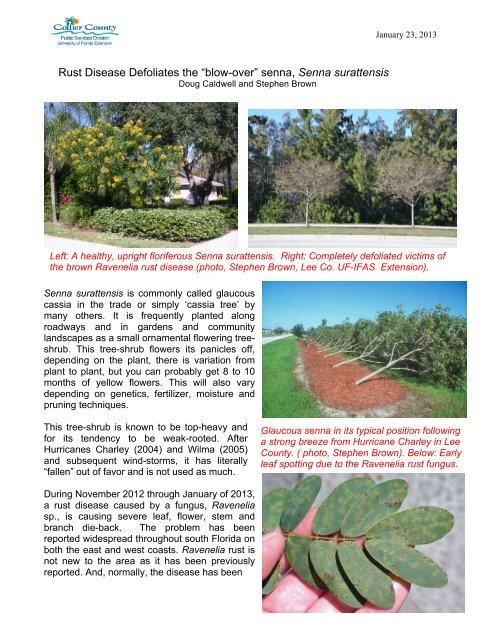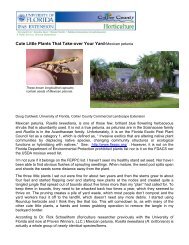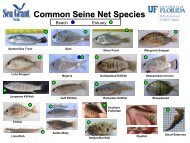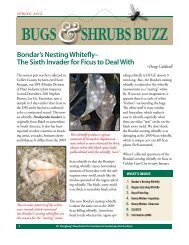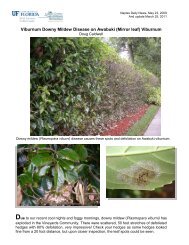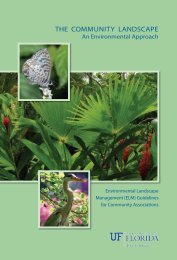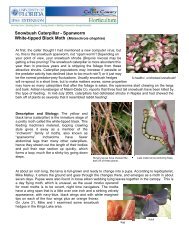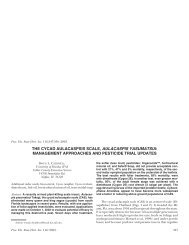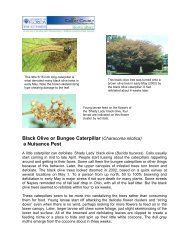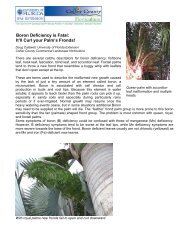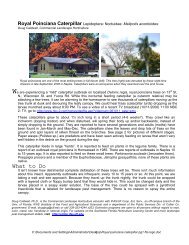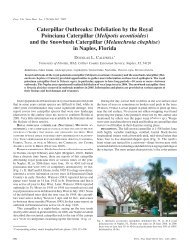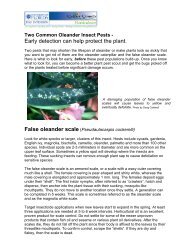Senna - Collier County Extension Office - University of Florida
Senna - Collier County Extension Office - University of Florida
Senna - Collier County Extension Office - University of Florida
You also want an ePaper? Increase the reach of your titles
YUMPU automatically turns print PDFs into web optimized ePapers that Google loves.
Rust Disease Defoliates the “blow-over” senna, <strong>Senna</strong> surattensis<br />
Doug Caldwell and Stephen Brown<br />
<strong>Senna</strong> surattensis is commonly called glaucous<br />
cassia in the trade or simply ‘cassia tree’ by<br />
many others. It is frequently planted along<br />
roadways and in gardens and community<br />
landscapes as a small ornamental flowering treeshrub.<br />
This tree-shrub flowers its panicles <strong>of</strong>f,<br />
depending on the plant, there is variation from<br />
plant to plant, but you can probably get 8 to 10<br />
months <strong>of</strong> yellow flowers. This will also vary<br />
depending on genetics, fertilizer, moisture and<br />
pruning techniques.<br />
This tree-shrub is known to be top-heavy and<br />
for its tendency to be weak-rooted. After<br />
Hurricanes Charley (2004) and Wilma (2005)<br />
and subsequent wind-storms, it has literally<br />
“fallen” out <strong>of</strong> favor and is not used as much.<br />
During November 2012 through January <strong>of</strong> 2013,<br />
a rust disease caused by a fungus, Ravenelia<br />
sp., is causing severe leaf, flower, stem and<br />
branch die-back. The problem has been<br />
reported widespread throughout south <strong>Florida</strong> on<br />
both the east and west coasts. Ravenelia rust is<br />
not new to the area as it has been previously<br />
reported. And, normally, the disease has been<br />
January 23, 2013<br />
Left: A healthy, upright floriferous <strong>Senna</strong> surattensis. Right: Completely defoliated victims <strong>of</strong><br />
the brown Ravenelia rust disease (photo, Stephen Brown, Lee Co. UF-IFAS <strong>Extension</strong>).<br />
Glaucous senna in its typical position following<br />
a strong breeze from Hurricane Charley in Lee<br />
<strong>County</strong>. ( photo, Stephen Brown). Below: Early<br />
leaf spotting due to the Ravenelia rust fungus.
fairly mild, only causing leaf<br />
drop. However, during this year’s brief cool<br />
season, severe defoliation and twig dieback has<br />
occurred. Stephen Brown reports 80% <strong>of</strong> the<br />
sennas have been defoliated in Lee Co. Because<br />
this plant tends to look ratty and thin after cold<br />
spells, this rust disease may have been at work in<br />
the past but overlooked (by me anyway!).<br />
Additional laboratory analyses are ongoing to<br />
gather more information on this disease. At this<br />
point, January 18, new growth is pushing out and<br />
the trees may recover. If you would like to use a<br />
fungicide, products such as Bayleton, Banner,<br />
Heritage or Pageant have been suggested by<br />
plant pathologist, Dr. Aaron Palmateer, with the<br />
<strong>University</strong> <strong>of</strong> <strong>Florida</strong>. Reapply applications per<br />
label directions. Another cure, in my opinion, is cut<br />
them down. Structurally they are an inferior plant<br />
species and don’t hold up when the strong winds<br />
blow.<br />
Also, for some reason people don’t remove the<br />
hardware from these plants after they have been<br />
propped up after a “blow over” event, like a car<br />
going by at 20 MPH. Another reason they may be<br />
defoliating is because they are strangled by the<br />
girdling wire and twine and stakes which should<br />
have been removed/adjusted within 6 to 12<br />
months after they were staked.<br />
Thanks to Lee Co <strong>Extension</strong> educator Stephen Brown<br />
for his help in this article and see his informative fact<br />
sheet at:<br />
lee.ifas.ufl.edu/Hort/GardenPubsAZ/<strong>Senna</strong>surattensisg<br />
laucouscassia.pdf<br />
Top: The rust disease at an advanced<br />
stage, note larger leaf spots and twig<br />
die-back.<br />
Middle: close-up <strong>of</strong> senna rust fruiting<br />
bodies and spores.<br />
Bottom: Support pole and cords need<br />
to be removed after 6 to 12 months.<br />
This tree is close to being girdled by<br />
the very people who sought to save it!<br />
January 23, 2013


